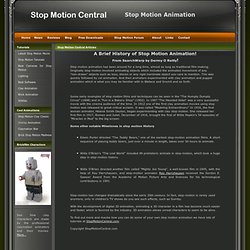

A Short History of Stop Motion. As Coraline hits theaters, FilmInFocus' Nick Dawson takes a whistle-stop trip through the history of cinema's most intricate art, stop motion animation.

Perhaps nothing realizes the promise of cinema more than stop motion animation. The magic of film, that dream we project onto the white space between images, is most clearly realized in the painstaking process by which filmmakers animate the inanimate and breathe life into the lumps of clay and sticks of wood. Indeed stop motion touches on almost medieval fantasy, the alchemy of bringing the dead to life. In truth, it is an arduous art, shooting scenes frame by frame, changing only a small movement with each shot. The Art of Stop-Motion Animation > Timeline of Important Events in the History of Stop-Motion Animation. A Short History of Stop-Motion Animation. Stop-motion has been around since the late 1800's.

It involves adding movement to inanimate objects. Learn more about the history of stop-motion animation after the break. In the early days of stop-motion animation, inanimate objects were used. The object was photographed, moved a bit and then photographed again. This process is repeated a number of times. Emile Cohl Emile Cohl, a French cartoonist and animator, was the one who brought stop-motion animation to America. Willis O’Brien Willis O’Brien was a special effects artist for motion pictures. The Advanced Art of Stop-Motion Animation: History of Stop-Motion Feature Films: Part 1.
Buy The Advanced Art of Stop-Motion Animation by Most of the stop-motion animation produced in the past century of which most audiences are has been done for either short formats or special effects.

The earliest stop-motion films were merely experiments in moving objects before the camera, like Bewitched Matches (1913) and The Automatic Moving Company (1912). The former was actually a stop-motion sequence for a live-action short. American puppet films lasting only 7 to 12 minutes were produced by Kinex Studios for home viewing and by George Pal for theatrical distribution, while the Czech movement of puppet film shorts began overseas in Eastern Europe.
At the same time, stop-motion effects for creature sequences in live-action fantasy films began with the innovations of Willis O’Brien and Ray Harryhausen, moving onto Star Wars and countless other films of the 1980s. A running time of anywhere from approximately 61 to 120 minutes [Figure 1.1] A scene from Ladislas Starewitch’s Starewitch.) GeekBomb: A Brief History of Stop-Motion Animation. Editor’s Note: This is the debut post by Kevin Kelly, who will be offering his expertise in geekdom in a new /Film daily blog feature called GeekBomb.

Welcome Kevin to /Film! Neil Gaiman’s Coraline opens this weekend, and it’s directed by Henry Selick, one of the few modern masters of stop-motion animation. Although he was trained as a traditional animator, he really came to fame with stop-motion, having directed The Nightmare Before Christmas, James and the Giant Peach, and Monkeybone. In the day and age of everything being whipped up in CGI, it’s really a testament to see people work in a medium that requires hours of tedious work on films that can take an extremely long time to produce. Which is why the Sundance opening night film Mary & Max was such a treat. Whenever someone mentions stop-motion, most people tend to think of one of the above movies, or the equally excellent Chicken Run or Wallace & Gromit: Curse of the Were-Rabbit, both co-directed by the amazing Nick Park. Stop motion. A Brief History of Stop Motion animation. Stop motion animation has been around for a long time, almost as long as traditional film-making.

Originally stop motion involved animating objects which included the animated movement of any "non-drawn" objects such as toys, blocks or any rigid inanimate object you care to mention. This was quickly followed by cel animaiton. And then animators experimented with clay animation and puppet animation which is what you may be familiar with in Wallace and Gromit and so forth. Some early examples of stop motion films and techniques can be seen in the "The Humpty Dumpty Circus" (1898) and in "Fun in a Bakery Shop" (1902).
Film in the Classroom. Stop-Motion Animation - Box Office History. The Official Website. TFS Essentials: Stop-Motion Animation - Toronto Film Scene Last month, while standing in an interminable holiday rush line at Shopper’s Drug Mart, I was confronted by one of those stand-up cardboard displays meant to tempt a last second impulse buy.

The cynicism with which I would typically greet such a crass commercial come on instantly melted away when I saw what the come on was for – the stop-motion animated classic Holiday specials of the late ’60s and early ’70s of creative team Arthur Rankin, Jr. and Jules Bass. With DVDs on offer of Rudolph the Red Nosed Reindeer , The Little Drummer Boy , Frosty the Snowman , and Santa Claus is Comin’ to Town , I was transported to my childhood when Christmas miracles were still possible and stop-motion animation, particularly “claymation” abounded. It was enough to give me the warm and fuzzies. As delightful as those holiday specials of my childhood were, I did eventually outgrow them.